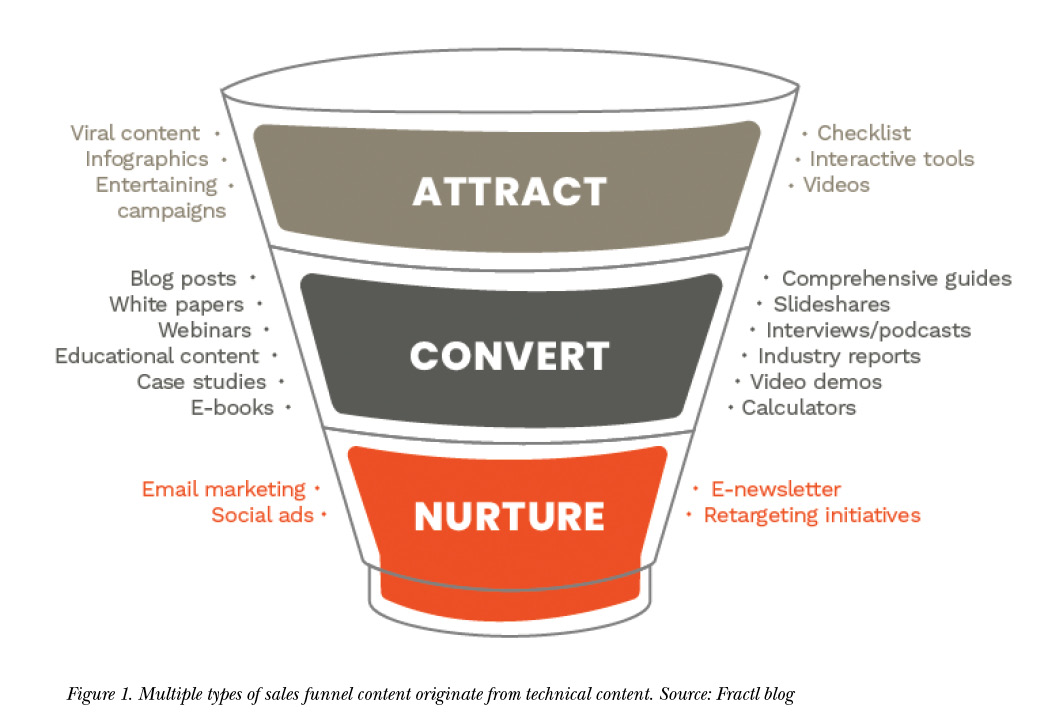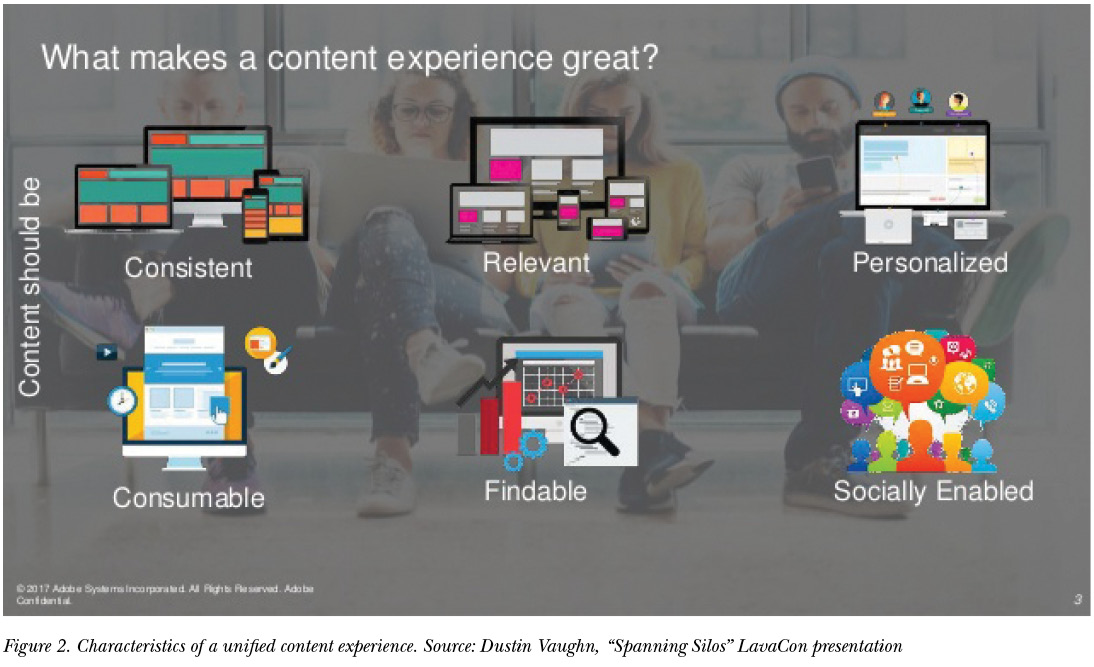By Alyssa Fox
Collaboration. It’s a word we hear all the time. It’s the new way of managing. It’s the new way of working. It’s the new way of communicating. But how do we actually put it into practice? And how important is it—really—to content teams and efforts?
Your organization wants to attract prospects interested in solving their problems with your solutions, educate those prospects, and ultimately drive long-term engagement and trust with them. Creating and publishing useful and usable content is one of the most impactful ways of providing the value your buyers and customers are looking for, and when technical and marketing teams join forces to deliver that content, collaboration multiplies the effectiveness of that effort.
Technical communication, at its core, is information that helps users accomplish tasks in a product or service. The goal of that technical information is to minimize frustration and help readers use the product in the most efficient way to achieve their goals in the larger context of their daily job. While documentation is most often targeted to be used after purchase, it’s also a key evaluation point in the buyer’s journey as prospects research potential solutions to address their pain points.
Content marketing is a marketing approach that focuses on creating informative and valuable content to help buyers understand and solve their issues, as opposed to straight selling of a product or service. Today’s buyers spend a large part of the sales cycle researching on their own. According to Demand Gen’s 2020 Content Preferences Study, 67% of respondents said they rely on content even more than they did last year to research and inform purchase decisions.
Because both of these types of content require an examination of a target audience and its needs, an understanding of the use cases behind those needs, a clear way to address those needs, and a desire to build trust through valuable information, it’s easy to see why collaboration between technical and marketing content is so crucial. Both teams will benefit from working together to understand their part in achieving their organization’s business goals and building a strong foundation of collaboration.
Benefits of Content Collaboration
When technical and marketing content teams align to make their working relationship collaborative, there are both internal and external benefits. On the technical side, gaining insight into outcome-focused language can be a game-changer for documentation. It’s easy for technical communicators to get bogged down in only the tasks and actions for which they’re providing instructions. Working closely with marketing, however, sheds light on how users’ needs are met with the product or service they’re documenting. Weaving that information into the documentation in the appropriate places makes that communication more effective by showing an understanding of, and empathy for, users’ pain points and how they’re addressed. Adding information that shows you understand and care about a user’s challenge also focuses the communication on the user, not on the product, which can inspire brand loyalty.
Another benefit that technical content teams receive from tighter collaboration with marketing is more visibility within marketing of the value technical content brings to the business and its bottom line. High-quality documentation published on the web provides immense value to an organization in the following ways:
- Providing technical requirements early in a buyer’s research
- Improving product trial experiences and making them easier
- Optimizing content for search engines
- Helping retain customers
Marketing teams will hopefully recognize the value that the documentation brings to their own efforts in attracting potential buyers with informative content and will work closely with the technical content team in that regard. Technical content can be a springboard from which to launch multiple types of content, including blog posts, technical white papers, videos, and more. Technical content also enables marketers to guide buyers through a content path from a high-level story to product positioning to technical information that supports that overall consistent story. As Figure 1 shows, multiple types of content used in the sales funnel can originate from technical content.
 Marketing teams can also use metrics from the online documentation to determine what users are reading about most or skipping over, as well as the paths they travel from one piece of content to the next. Armed with this information, teams can target content marketing specifically to what users are looking for most often and adjust positioning based on how users actually use the products, rather than trying to guess.
Marketing teams can also use metrics from the online documentation to determine what users are reading about most or skipping over, as well as the paths they travel from one piece of content to the next. Armed with this information, teams can target content marketing specifically to what users are looking for most often and adjust positioning based on how users actually use the products, rather than trying to guess.
Finally, since technical communicators are content creation and publishing professionals, they typically have a more defined and structured approach to content delivery that marketing teams can learn from. A consistent workflow and measurement methodology contribute to higher quality content and feed a stronger understanding of product usage and content performance back into marketing content plans.
A Shared Content Vision and Goals
Although it seems basic, it’s worth reiterating that to make this collaboration work, the technical content and marketing teams must have a shared vision for their content. That shared vision must be based on business outcomes—they’re what will resonate with the content consumer, whether that consumer is
- a prospect trying to learn more about their particular challenge,
- a buyer who’s at the point in the research process of selecting options to solve that challenge, or
- a user who’s already bought the solution and is trying to make it work for them.
After your teams have worked together to define that shared vision, they should work together to define joint goals, such as the following:
- Creating or improving a unified customer experience
- Aligning technical and marketing content
- Driving awareness and leads through SEO
Unified Customer Experience
With both the technical content and marketing teams writing content with this vision in mind, their content will help the organization build a relationship with the audience, improving the customer experience and enhancing brand perception. Ensure that the technical content and marketing content look and feel similar, with the same branding, messaging, and style applied. Your reader should never notice that different types of content come from different teams, or their experience will be disjointed and will distract from the information they’re meant be consuming. Collaborate around the content characteristics that will provide your customers with a unified content experience; some are suggested in Figure 2.
Technical and Marketing Content Alignment
As previously mentioned, the types of questions you’re answering with your technical content can provide a wealth of potential topics for marketing content—thought leadership, tutorials, videos, and infographics, to name a few. The idea is not to copy topics verbatim from documentation, but to take a technical concept and repurpose it into a higher-level thought leadership content asset. For example, a topic about configuring master account dashboards in a user guide might convert to a thought leadership piece on “Strategies for Effectively Managing Multiple Accounts.” The higher-level piece can serve as an introduction to the topic, and the ability to drill down into the more technical topic gives you an opportunity to build a relationship with a technical audience from the very beginning, even before they buy.
SEO Value to Drive Awareness and Leads
Technical communication plays an important role in helping users better understand a product and accomplish certain tasks. When looking for answers to their questions, users or prospective buyers often search online. Include keywords in your documentation for which you want your organization to appear in search engine results, and ensure your documentation is properly indexed to appear in results along with the rest of your website. The exposure to your products and company is also beneficial because technical content needs to be authoritative and technically accurate. Because company authority is a key ranking factor on search engines, including your technical documentation for SEO purposes can make a big impact on marketing efforts to drive awareness of your company.
Additionally, consider linking from the documentation to some of your marketing content and vice versa. The richer the relationship among your various types of content online, the more relevant search engines find those topics when searching based on keywords. Tracking users’ paths between these linked types of content also gives you additional information on what readers are interested in hearing more about and where they go next to get that information.
Making Content Collaboration Work
Once the content teams jointly define their content vision and goals, it’s time to put the people, processes, and technology in place to accomplish those, as shown in Figure 3.
People
Everyone needs to feel that their voice is being heard—whether they’re on the technical content team or marketing team. True collaboration will happen only if this is the case. To that end, it’s a good idea to have a trusted leader who can oversee the discussions necessary to ensure everyone is heading down the right path.
Additionally, putting the right people in the right roles is essential. The technical content team should serve as a bridge between the product team and the marketing team. The marketing team should actively seek input from the technical content team. The relationship between these teams must be proactive and respectful to ensure the collaboration needed to accomplish jointly defined goals. Look at different personalities and strengths across both teams to ensure that each team member is able to own an aspect of the content process and is willing to work with others in the larger effort.
Processes
Unified consensus in overall content strategy and creation methods will facilitate the most effective collaboration. That doesn’t mean everyone has to agree on every detail, but frequent communication led by a trusted leader helps ensure that everyone’s voice is heard. Hold regular meetings and make impromptu conversations a habit to keep everyone headed down the same path.
Defining and documenting a consistent content workflow across the technical content and marketing teams reduces internal squabbles over how to plan, create, review, and publish content, saving time and money. Creating a collaborative content calendar gives visibility into each team’s content plans, offering an opportunity for content atomization and reuse. A content calendar also opens the floor for discussion about the best publishing channels for each content asset, along with an exchange of ideas for how to promote and publicly highlight the content. Does a linear approach work, with separate teams for content creation, design work, and publishing? Should you use an agile approach? There are numerous other processes to consider when creating and publishing content; take time to discuss these with your teams and decide which processes to prioritize to maximize collaboration and efficiency in your organization.
Technology
Technology is a huge assistant in reducing duplicate work, eliminating confusion, and maximizing collaboration. What types of tools should you consider to enable technical content and marketing teams to work more efficiently together?
Depending on your organization’s size, budget, and content production maturity, you might consider content management systems, collaborative editing tools for simultaneous review, content analytics tools, or content marketing platforms. Don’t forget the more basic tools that make a difference as well, such as collaborative communications tools that enable real-time conversations across multiple time zones and teams, including video where needed.
Conclusion
Building relationships with buyers and users is at the core of brand loyalty, and informative, helpful, and relevant content is one of the most important components of building trust in that relationship. Unifying technical communication and marketing teams to provide a cohesive and consistent story about the pain points their buyers are facing and how to solve those problems is a worthy investment for your company to make. An enthusiastic collaboration between those teams raises the quality of your content, improves the buyer journey, and ultimately positively impacts your bottom line—and that’s the success we’re all looking for.
Alyssa Fox (alyssafoxstc@gmail.com) is a content strategist and marketing leader who thrives on improving customer experience through brand consistency and relevant information. She’s a champion for cultures that position content to drive leads, revenue, and customer retention. Alyssa has vast management experience across global teams and has worked on numerous cross-functional initiatives to improve processes and communication across organizations.
References
Carlisle, Ashley. 2019. “Choosing the Right Types of Content Marketing for Every Stage of the Buyer’s Journey.” Fractl,
4 March 2019. https://www.frac.tl/use-content-marketing-different-areas-buying-cycle.
Vaughn, Dustin. 2017. “Spanning Silos: Combining Marketing and Technical Content to Deliver a Consistent
Customer Experience.” LavaCon Content Strategy Conference. November 2017. https://www.slideshare.net/JackMolisani1
/lavacon-2017-spanning-silos-combining-marketing-and-technical-content-to-deliver-a-consistent-customer-experience.
Transparency Market Research. n.d. “Research on Enterprise Content Management Market – Industry Analysis and Forecast 2013–2019.” Accessed 6 August 2020. https://pitchengine.com/pitches/9a95ccce-8fc1-4e6b-a6f9-96f1a1624617.




